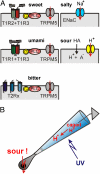The sour taste of a proton current
- PMID: 21149726
- PMCID: PMC3009779
- DOI: 10.1073/pnas.1016810108
The sour taste of a proton current
Conflict of interest statement
The author declares no conflict of interest.
Figures

Comment on
-
A proton current drives action potentials in genetically identified sour taste cells.Proc Natl Acad Sci U S A. 2010 Dec 21;107(51):22320-5. doi: 10.1073/pnas.1013664107. Epub 2010 Nov 23. Proc Natl Acad Sci U S A. 2010. PMID: 21098668 Free PMC article.
References
Publication types
MeSH terms
Substances
LinkOut - more resources
Full Text Sources

